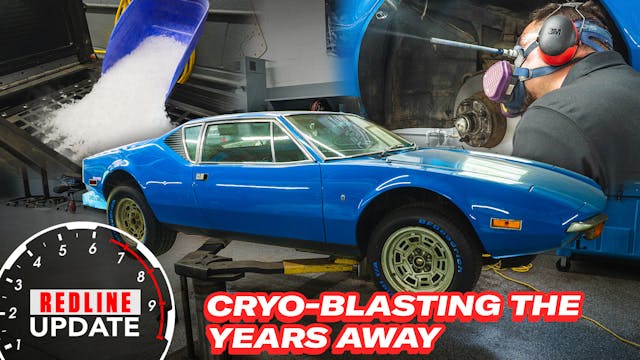Cryoblasting Our Barn-Find Pantera Made It Look Like New
Unless you’re rolling it out of a trailer for two car shows a year, the life of your hobby car is probably going to involve some tough run-ins with dirt, grime, and other detritus that are all but inescapable in everyday life. Add in nearly four decades of slumber in a dusty barn, and things go to a whole other level.
The barn-find DeTomaso Pantera that Tom Cotter discovered in North Carolina a while back has been getting quite the second shot at life. Davin and his merry band of wizards breathed new life into the Ford 351 Cleveland V-8 in the latest edition of our famous Redline Rebuild series, but the goal was never just to freshen up the motor. We wanted to put this Pantera back on the road, looking as good as it did the day it rolled off the assembly line.

That’s where cryoblasting (the cool-kid term for dry-ice blasting) comes in. The relatively new method of car detailing involves using little pellets of dry ice to blast away debris and dirt that have been caked on over years of use. Think of the materials that even the best power washers can’t touch without risking the finish of what’s underneath.
Tom takes the engineless Pantera to Jared Friends of Merritt Motors, a specialty dealer out of Kannapolis, North Carolina, that offers dry-ice blasting as well. As Jared explains it, despite being relatively new to the automotive world, cryoblasting has been around for a few decades in the manufacturing and food service industries. “[It’s used] to clean any surface where you don’t want to damage the substrate underneath,” explains Friends.

Dry-ice blasting has a far more exacting level of cleaning capability than blasting with another media like sand or walnut shells would, he says. In the case of the Pantera, Tom is hoping to see the original undercoating remain intact, but also to see all of the dirt and grime that’s worked its way into said undercoating removed. As Jared shows Tom, the pressure and particle size are both highly customizable, depending on the application and the desired outcome.
Watching Jared and his colleagues work is downright mesmerizing. You can see the gun turn the surface white temporarily, as the dry ice freezes everything it touches. Then, as it evaporates, what’s left is a dirt-free surface that still has the factory undercoating intact—just like Tom had hoped.
Perhaps most impressively, the process seems relatively surface-agnostic. Whether Jared and his crew were spraying steel on the frame, body panels, exposed mechanical components, or wires and rubber grommets, the cryoblasting has no trouble removing half a century of build-up.

Just before the halfway point in the video, the team pauses to do a side-by-side comparison between the treated areas and the untreated areas. The difference is astonishing; Tom is completely blown away. By the time the crew is finished, the Pantera looks nearly as good as new. In fact, the finish is so solid that Tom and Kyle, Jared’s associate, are analyzing the quality of the application of the original factory undercoating in areas, noticing inconsistencies with the way the Italian assembly workers treated areas on the Pantera.
On the second day, Tom and the car’s owner, Brian Cotter, get a chance to try their hand at the cryoblasting process. Both are amazed at how straightforward the application is. Before long, they’re both having a great time blasting away at the built-up grime. Eventually the transmission gets the same treatment, taking the gearbox back to near-as-new. Even the interior panels get touched up.

“It’s going to be so nice to work on,” says Tom. “It’s oddly satisfying to use the machine,” agrees Brian. “It’s remarkable the amount of different materials you can clean up with this process.”
We couldn’t agree more. Check out the full transformation by watching the video below.
***
Check out the Hagerty Media homepage so you don’t miss a single story, or better yet, bookmark it. To get our best stories delivered right to your inbox, subscribe to our newsletters.



The jar of “product” at the end was pretty funny.
How much did that cost you
OK, looks like they went thru that whole case of dry ice, so that’s $1000, and it was 2 days of work, so you gotta be talking somewhere between $1500 and $2000 to get the car cryo-blasted. That’s just the cleaning phase, a lot of that stuff will be replaced (I.e. rubber hoses, brake lines, ball joints, bushings). Looks pretty expensive with the only advantage being no media contamination (sand, glass bead, baking soda, etc). I wonder how much of that cleaning could have been soap and water?
After no more than 5 minutes you will stop wondering.
It is not cheap, but sure does a great job and the mess needed to clean it up is far easier. You tend not to need a drain in your garage floor and need no pollution containment system, but you need to keep things cover to prevent the airborne debris from resettling on something else.